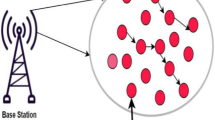Abstract
Significant growth of smart home devices is adopted, which provides security, convenience, and energy efficiency for users, in recent years. As an instance, consider a secured smart camera that detects movements of unauthorized objects, whereas the fire accidents can be detected by smoke sensors. Though, a surface for new cyber threats is some of the most recent examples that are open up in this field. Furthermore, recent examples also show that the distributed denial of service (DDoS) attacks are performed by misusing the smart devices which are hacked violating the privacy rules. In this proposed work, the application of machine learning in an environment of smart homes is explored so that the anomalous activities that occur can be identified. The sensor data at the network level is trained using a model based on the Markov chain known as hidden Markov model (HMM) and is created using smart devices and multiple sensors from a testbed. The model generated using HMM achieves 97% accuracy while detecting potential anomalies where attacks are indicated. In this approach, we construct the model and differentiate the analysed results with existing techniques. The starting step for securing IoT networks is intrusion detection and the next step is the intruders prediction which provides an active defence against the incoming attacks. The model employs an algorithm that does not depend on specific domain knowledge. The work has achieved an improvement in prediction accuracy of 5% for an alert category over the current variable length methods of Markov chain intrusion prediction, as they provided information more for a possible defence. The DDoS attack is considered as a coordinated attack mainly carried out based on a large scale depending on whether the target system’s resources or services are available. Thus, the novel approach also describes a novel machine learning-based technique using an algorithm known as variational dynamic Bayesian algorithm which helps to obtain a HMM with the number of parameters and model states which are optimized for the prediction of a DDoS attack. This procedure conquers the speed of a moderate combination HMM approach.









Similar content being viewed by others
References
Xu F, Ye H, Yang F, Zhao C (2019) Software defined mission-critical wireless sensor network: architecture and edge offloading strategy. IEEE Access 7:10383–10391
Titouna C, Naït-Abdesselam F, Khokhar A (2019) DODS: a distributed outlier detection scheme for wireless sensor networks. Comput Netw 161:93–101
Wang J, Gao Y, Liu W, Sangaiah AK, Kim HJ (2019) An improved routing schema with special clustering using PSO algorithm for heterogeneous wireless sensor network. Sensors 671–688
Sharma S, Gupta RK (2015) Intrusion detection system: a review. Int J Secur Appl 9(5):69–76
Afolorunso AA, Adewole AP, Abass O, Longe HOD (2016) Kullback–Liebler divergence for reducing the observable states space of hidden Markov model for predicting distributed denial of service attack. In: 11th Unilag conference and fair, 2016, Lagos, Nigeria, Proceedings, pp 184–193
Badajena JC, Rout C (2012) Incorporating hidden Markov model into anomaly detection technique for network intrusion detection. Int J Comput Appl 53(11):42–47
The statistics portal, statistics and studies from more than 22,500 sources, 2017. Last Accessed 27 Feb 2019
Robinson S (2019) Smart home attacks are a reality, even as the smart home market soars. Last Accessed 27 Feb 2019
Martin C (2017) North American consumers to have 13 connected devices. Last Accessed 27 Feb 2019
Novák M, Jakab F, Lain L (2013) Anomaly detection in user daily patterns in smart-home environment. J Sel Areas Health Inform 3(6):1–11
Gai K, Qiu M (2018) Blend arithmetic operations on tensor-based fully homomorphic encryption over real numbers. IEEE Trans Ind Inform 14(8):3590–3598
Emperuman M, Chandrasekaran S (2020) Hybrid continuous density HMM-based ensemble neural networks for sensor fault detection and classification in wireless sensor network. Sensors 20(3):745
Khosronejad M, Sharififar E, Torshizi HA, Jalali M (2013) Developing a hybrid method of hidden Markov models and C5.0 as an intrusion detection system. Int J Database Theory Appl 6(5):165–174
Rao PRM, Reddy KV, Hemanth SV (2012) Minimizing application layer DDoS attacks using website customization. Int J Comput Sci Technol 3(4):838–841
Divya T, Muniasamy K (2015) Real-time intrusion prediction using hidden Markov model with genetic algorithm. In: Suresh L, Dash S, Panigrahi B (eds) Artificial intelligence and evolutionary algorithms in engineering systems. Advances in intelligent systems and computing, vol 324. Springer, New Delhi
Thanthrige USKPM, Samarabandu J, Wang X. Intrusion alert prediction using a hidden Markov model. https://arxiv.org/pdf/1610.07276. Accessed Jan 2017
Kanev A, Nasteka A, Bessonova C, Nevmerzhitsky D, Silaev A, Efremov A, Nikiforova K (2017) Anomaly detection in wireless sensor network of the smart home system. In: 2017 20th Conference of open innovations association (FRUCT). IEEE, pp 118–124
Arrington B, Barnett LE, Rufus R, Esterline A (2016) Behavioral modeling intrusion detection system (BMIDS) using internet of things (IoT) behavior-based anomaly detection via immunity-inspired algorithms. In: 2016 25th International conference on computer communication and networks (ICCCN). IEEE, pp 1–6
KrebsonSecurity (2019) Mirai botnet authors avoid jail time. Last Accessed 27 Feb 2019
Gai K, Choo K-KR, Qiu M, Zhu L (2018) Privacy-preserving content-oriented wireless communication in internet-of-things. IEEE Internet Things J 5(4):3059–3067
Warrender C, Forrest S, Pearlmutter B (1999) Detection of intrusion using system calls: alternative data models. In: IEEE symposium on security and privacy. http://www.researchgate.net/publication/2448365_Detecting_Intrusions_Using_System_Calls_Alternative_Data_Models. Accessed Dec 2016
Micro T (2019) New rapidly-growing IoT botnet—reaper. Last Accessed 27 Feb 2019
Gai K, Wu Y, Zhu L, Qiu M, Shen M (2019) Privacy-preserving energy trading using consortium blockchain in smart grid. IEEE Trans Ind Inform
Zeng Y, Qiu M, Ming Z, Liu M (2018) Senior2local: a machine learning based intrusion detection method for vanets. In: International conference on smart computing and communication. Springer, pp 417–426
Author information
Authors and Affiliations
Corresponding author
Rights and permissions
About this article
Cite this article
Kalnoor, G., Gowrishankar, S. A model for intrusion detection system using hidden Markov and variational Bayesian model for IoT based wireless sensor network. Int. j. inf. tecnol. 14, 2021–2033 (2022). https://doi.org/10.1007/s41870-021-00748-1
Received:
Accepted:
Published:
Issue Date:
DOI: https://doi.org/10.1007/s41870-021-00748-1




